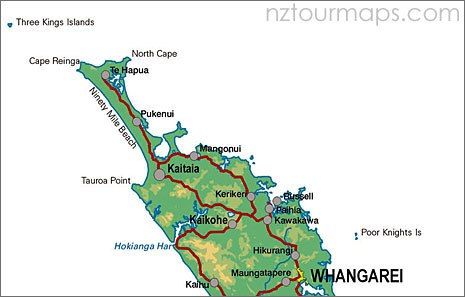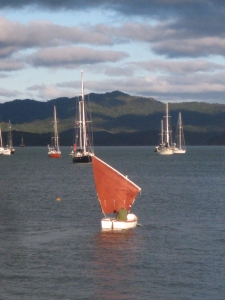T and I travelled to the Bay of Islands this past weekend to celebrate his birthday early (unbelievably, our birthdays are only a day a part, and I have this thing about birthdays being both individual and individually special). I had never been and he had only been there once or twice.

The top of the North Island. We started in Whangarei, drove to Pahia, Russell, Opua, and Kerikeri, and across to Kaihohe and Hokianga
The Bay of Islands is considered a wee gem, even by New Zealand standards. Sometimes, it feels like you’re visually overstimulated living here. You can’t appreciate the pretty because there’s no “ugly”, there’s no wretchedness.
This trip was beautiful. And it was ugly. And at the end of it, I came away enriched in ways I couldn’t have anticipated. There are four reasons for this—some light-hearted, some just gorgeous, and others troubling and unsettling. But first, let’s start with the fun.
Reason number 1: The toilets
We flew into Whangarei and then drove to Paihia, stopping in Kawakawa for a break at the famous Hundertwasser Toilets. Frederic Hundertwasser was a Viennese architect with a very, erm, interesting aesthetic. He bought a second home on the coast near Kawakawa. When the local council announced in 1998 that they wanted to refurbish the 40 year old toilets, he volunteered a design in his idiosyncratic style. Given the whimsical approach New Zealand takes to many public spaces, it’s not surprising that Hundertwasser’s plan was adopted, grass roof and all. The design also includes a living Macropiper excelsus tree, after which the town is named (The Maori word for the tree is Kawakawa). This was the only building he designed in the southern hemisphere, and it now is probably the most photographed public toilet in the world. It’s also, the weirdest. Here are a few of my pictures of it:
Reason number 2: Stunning landscapes.
This is simply photo porn. Enjoy!
Reason number 3: Standing up for what’s right.
This was an unexpected experience and one—on reflection—I’m grateful for.
We took the ferry over to Russell from Paihia—all of a 5 minute trip. Russell is a lovely, resortish sort of place full of boutiques, cafes, and old buildings with historical markers. It is also the first capital of New Zealand and the sight where European settlers arrived, including Anglican missionaries who witnessed to the local Maori population. It reminded me a bit of a seaside Savannah.
You could really feel the history in some of the places. As I sat in one, alone and deep in thought, a woman came in with cleaning supplies. She was on the building’s cultural board and it was her weekend to tidy up. We struck up a conversation. She was from the UK originally, but had lived in New Zealand for about thirty years. We talked about Savannah and the South. She mentioned that the evening before she had attended a Thanksgiving dinner with some people from New Orleans.
What I’m leading up to starts with what she said next.
“They said that there was still so much racism there,” she said.
Not sure where she was going with this, I replied, “I think it’s fair to say that racism exists everywhere.”
“Well not here. There’s no racism here.”
I think my raised eyebrows gave away my surprise.
She explained. “It’s not about racism with the Maoris. It’s about role models. They aren’t very good role models for their children, are they?”
“Excuse me?”
She leaned in a way that I can only describe as conspiratorial. And it angered me. “They’re all on the benefit. All they’re doing is teaching their kids to be lazy and live on the benefit.”
At this point, I had a choice. I could smile benignly and change the subject, thus letting it go, or I could say something.
I said something.
“I don’t think that’s really accurate,” I began. “And, regardless, it’s not about role models. It’s about ending a cycle of oppression and racism. That takes a long time– it’s endemic *and* systemic. You can’t just change that overnight. And to say that racism doesn’t exist here is just… well, I’m sorry, but it’s just wrong.”
She waved her hands in the air. “Oppression? Racism? I think that’s debatable.”
“There’s nothing debatable about laws that basically stripped Maori of their property or that laws that prohibited Maori children from speaking their own language in public,” I said, genuinely angry at this point. “ I don’t know what you call it, but that sounds like oppression and racism to me.”
Before she could reply, we were interrupted by a jovial older man who came in to join her in her cleaning. She turned away and I returned to some quiet contemplation. I think God was probably looking out for us both in that moment.
I was seething inside, though. The conversation had really bothered me, for obvious reasons. But what really angered me was that she somehow thought I might be sympathetic to what she was saying. Was it because I was an immigrant, like her? Was it because I was a white girl from the South? Was I being overly sensitive to the issue because I *am* from the South and race relations are always present somewhere in the periphery. I don’t know. At this point, I don’t care, but I was honestly astounded that she believed that these were “truths” and thus safe to share with a total stranger.
It rattled me in ways I hadn’t anticipated.
In fact, it still rattles me.
In contemplation, I am glad of two things. First, I am glad I said something. For lots of reasons I won’t go into here, people don’t always have the luxury of being able to say something. I know some would disagree with me on that point.
Second, it’s the first time I’ve encountered such direct statements about race in New Zealand, and honestly one of the few times I have encountered it in my life. That shows me that while there is obviously still a lot of work to be done, there’s a lot that has already been done. I can live with that. For now.
Reason number 4: Seeing where it all started
Tying everything together was our visit to the Waitangi Treaty grounds on our last day. Waitangi is typically translated as weeping waters. Though, some believe it can also translate into falling tears.
The Waitangi Treaty grounds is the site where the Treaty of Waitangi was signed between the Crown and the Maori. It is the birthplace of modern New Zealand. It’s where it all started for most of us. It’s where it changed for many others.
I thought about the Revolutionary War and the birth of America. I thought about the riots and the skirmishes and the wars going on all over the world over so many of the things that I experienced in the microcosm of our weekend away. Once again, I realised that the same struggles exist almost everywhere to one degree or another. That people are fighting, have fought, and will fight for many of the same things.
As I stood looking out over a gorgeous bay under the shade of century old trees, the Tui birds danced and sang on their branches. Anyone I know here will tell you that I have a thing about the Tui birds. I looked up and I smiled. And I thought to myself, “This is New Zealand,” this is the world, both the beautiful and the wretched.









